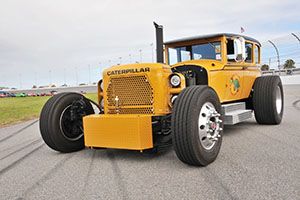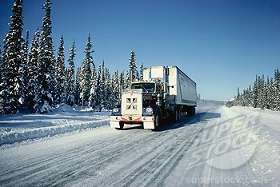60 Hour Local CDL School, Is That Enough?
Topic 19261 | Page 4

Chosen, nobody is going to dispense a medical device like a CPAP/VPAP/APAP without a prescription from a doctor. Once you have the RX, you can get it filled by just about any DME (Durable Medical Equipment supplier), online or brick and mortar. Or you can find them used on Craigslist for $0-200 if you want to go to the hassle of finding a clinical setup manual online and program it yourself.
If you are being ordered to get it by your MC, they might have their own ideas as to what hoops you need to jump through to achieve compliance.
Michelle, sorry for derailing your thread.
CPAP:
Constant Positive Airway Pressure
CPAP is a breathing assist device which is worn over the mouth or nose. It provides nighttime relief for individuals who suffer from Sleep Apnea.
Dm:
Dispatcher, Fleet Manager, Driver Manager
The primary person a driver communicates with at his/her company. A dispatcher can play many roles, depending on the company's structure. Dispatchers may assign freight, file requests for home time, relay messages between the driver and management, inform customer service of any delays, change appointment times, and report information to the load planners.HOS:
Hours Of Service
HOS refers to the logbook hours of service regulations.
No biggie, Taxman. The info is good for me too.

Have you taken a look at Wil-Trans and/or Jim Palmer Trucking? The training program is pretty much identical to Prime's that everybody has already talked about. After you are solo, you can bring your dog. With these two companies, there is not any breed or weight restrictions, which sounds right up your alley!
Here's a brief run down of these companies. Wil Trans (Wilson Logistics) bought JPT a couple of years ago. Sounds like they basically bought the good reputation of the JPT name, but is entirely owned by the guy that owns Wil Trans. They do not have their own sales team or accounts, they solely pull Prime's freight. So they are basically Prime without being Prime if that makes sense. (i.e., the qualcomm system is linked with Prime, you have access to Prime terminal facilities, the Prime mobile app. Heck, even when you set up direct deposit and move your funds from your Comdata Card to your personal bank account, your line item for that transaction on your bank states "Prime").
Between the two companies combined, they have about 500 trucks/drivers compared to something like 5,000 with Prime. Wil Trans supposedly runs mostly east of Ohio and Jim Palmer runs mostly west of Ohio. That said, they both go anywhere and hire from anywhere in the U.S. When it's time to go home, they'll simply make sure they get you a run ending near to you. After you drop off you can just take your truck home and park it wherever you're allowed to park a truck. (Or they'll find a nearest drop yard for you to leave it and you get yourself home. A recruiter can definitely help you out there telling you where the nearest drop point would be, but they tend to be all over the place and NOT just the terminals you see listed here on the company reviews).
Anyway, just thought I'd offer that up since I know how important a pet relationship can be. In fact, I think it's really smart for a trucking company to allow for bigger sized pets if ONLY for the fact that it kind of locks in their drivers from LEAVING. LOL ;)
Terminal:
A facility where trucking companies operate out of, or their "home base" if you will. A lot of major companies have multiple terminals around the country which usually consist of the main office building, a drop lot for trailers, and sometimes a repair shop and wash facilities.
Qualcomm:
Omnitracs (a.k.a. Qualcomm) is a satellite-based messaging system with built-in GPS capabilities built by Qualcomm. It has a small computer screen and keyboard and is tied into the truck’s computer. It allows trucking companies to track where the driver is at, monitor the truck, and send and receive messages with the driver – similar to email.Wil-Trans:

Darrel Wilson bought his first tractor in 1980 at age 20, but, being too young to meet OTR age requirements, he leased the truck out and hired a driver.
Through growth and acquisition, Wil-Trans now employs over 200 drivers, and has a long-standing partnership with Prime, Inc. to haul their refrigerated freight. The family of businesses also includes Jim Palmer Trucking and O & S Trucking.
EPU:
Electric Auxiliary Power Units
Electric APUs have started gaining acceptance. These electric APUs use battery packs instead of the diesel engine on traditional APUs as a source of power. The APU's battery pack is charged when the truck is in motion. When the truck is idle, the stored energy in the battery pack is then used to power an air conditioner, heater, and other devices

If you're a 'take control' sort of person, you'll want to have a data logging autopap so you can use Sleepyhead software or similar and view your sleep patterns. My Resmed AS10 logs every single breath I take. And I used that data to titrate my own ideal settings over a two month period, that work better than the titration established in a one night sleep study.
My RX was for an autoset machine, start at 5cm water column pressure, ramping to a range of 9-12cm as needed after I fell asleep. The first couple of weeks there were two times I woke up with the machine running at 12, my mouth open, air roaring in my nose and out my mouth and me unable to breath. I'd freak out and rip the mask off, and lay there gasping for breath. After the 2nd incident I looked up the clinical menu functions, and dialed the max down to 11. The problem was that if I dislodged the mask and caused a leak, the machine would respond by going to max pressure (good thing my doc prescribed 9-12 instead of doing the lazy method of setting it for 4-20 and letting the machine do all the deciding). But in my case, if it goes over 11 it breaks my soft palate and the air escapes out my mouth. Over time I learned that letting it start below 7 would give me a few minor apneas as I first fell asleep. I also learned that at 7cm I could virtually eliminate all apnea, and the few events I had would almost all be between 11 and 15 seconds duration. (any cessation of breathing up to 10 seconds isn't considered apnea)
I was lucky in that my DME gave me the machine I would have chosen if I'd researched the purchase before I let them dispense the machine.
If I had to do it all over again, I'd read the reviews, pick out my machine, and have my doctor prescribe that specific machine, "fill prescription as written".
http://www.apneaboard.com/forums/Thread-Wording-of-prescription
Dm:
Dispatcher, Fleet Manager, Driver Manager
The primary person a driver communicates with at his/her company. A dispatcher can play many roles, depending on the company's structure. Dispatchers may assign freight, file requests for home time, relay messages between the driver and management, inform customer service of any delays, change appointment times, and report information to the load planners.HOS:
Hours Of Service
HOS refers to the logbook hours of service regulations.The machines truckers use need to transmit the results over the road so they are different from home machines. If you stop using the machine, they will know way way before your next doctors visit.
If you are already diagnosed you must bring your data card with at least 30 days of 70% usage. You may still have to buy a machine, OR if your model.can be fitted with a transmitter it might work. I know one person whose machine could be fitted and one who needed to buy a new machine.
My guess is you would not be able to shop around because the transmitter would need to be compatible with the prime doctors. Prime pays for the machine upfront then makes weekly deductions from your pay.
Over The Road:
Over The Road
OTR driving normally means you'll be hauling freight to various customers throughout your company's hauling region. It often entails being gone from home for two to three weeks at a time.
HOS:
Hours Of Service
HOS refers to the logbook hours of service regulations.
I'm sorry I cannot remember who mentioned the YouTube video of the pre trip, and the video was educational and informative however I believe it is not complete. I must mention I do not have a cdl , nor my permit yet, but based on what I've read he did not check that any exterior lights were functioning. Low/high beams, turn signals, 4 ways, high road, and the manual say it is required.
Am I wrong??
CDL:
Commercial Driver's License (CDL)
A CDL is required to drive any of the following vehicles:
- Any combination of vehicles with a gross combined weight rating (GCWR) of 26,001 or more pounds, providing the gross vehicle weight rating (GVWR) of the vehicle being towed is in excess of 10,000 pounds.
- Any single vehicle with a GVWR of 26,001 or more pounds, or any such vehicle towing another not in excess of 10,000 pounds.
- Any vehicle, regardless of size, designed to transport 16 or more persons, including the driver.
- Any vehicle required by federal regulations to be placarded while transporting hazardous materials.

- Pre-Trip Inspection Study Guide
- Daniel's Pre-Trip Inspection
- Pre-Trip Inspection Checklist
- Pre-Trip Inspection Practice Questions
Exterior lights must be checked, usually done last and most test instructors will accept the following: "now that I've completed my in-cab inspection could you assist me with checking my exterior lights and signals?"
See above.
Pre-trip Inspection:
A pre-trip inspection is a thorough inspection of the truck completed before driving for the first time each day.
Federal and state laws require that drivers inspect their vehicles. Federal and state inspectors also may inspect your vehicles. If they judge a vehicle to be unsafe, they will put it “out of service” until it is repaired.
CDL:
Commercial Driver's License (CDL)
A CDL is required to drive any of the following vehicles:
- Any combination of vehicles with a gross combined weight rating (GCWR) of 26,001 or more pounds, providing the gross vehicle weight rating (GVWR) of the vehicle being towed is in excess of 10,000 pounds.
- Any single vehicle with a GVWR of 26,001 or more pounds, or any such vehicle towing another not in excess of 10,000 pounds.
- Any vehicle, regardless of size, designed to transport 16 or more persons, including the driver.
- Any vehicle required by federal regulations to be placarded while transporting hazardous materials.
OWI:
Operating While Intoxicated
I'm sorry I cannot remember who mentioned the YouTube video of the pre trip, and the video was educational and informative however I believe it is not complete. I must mention I do not have a cdl , nor my permit yet, but based on what I've read he did not check that any exterior lights were functioning. Low/high beams, turn signals, 4 ways, high road, and the manual say it is required.
Am I wrong??
I probably mentioned APEX but there's several videos. He broke them up into "part identification" and "in cab inspection" etc. If you check out his channel you can probably find the others. Remembering the lights is easy...you know what a light looks like. Identifying a brake chamber or steering linkage is much harder for some people. Some people get thrown by the part placement too...but know what the part looks like and you can find it whether on a Volvo or Cascadia. Learn the video before you go to school and anything missed by the video will be easier to learn and you will be way way ahead of the others in class.
CDL:
Commercial Driver's License (CDL)
A CDL is required to drive any of the following vehicles:
- Any combination of vehicles with a gross combined weight rating (GCWR) of 26,001 or more pounds, providing the gross vehicle weight rating (GVWR) of the vehicle being towed is in excess of 10,000 pounds.
- Any single vehicle with a GVWR of 26,001 or more pounds, or any such vehicle towing another not in excess of 10,000 pounds.
- Any vehicle, regardless of size, designed to transport 16 or more persons, including the driver.
- Any vehicle required by federal regulations to be placarded while transporting hazardous materials.
New Reply:
New! Check out our help videos for a better understanding of our forum features

















Preview:
This topic has the following tags:
CRST Van Expedited Prime Inc Swift Transport Attending Truck Driving School Becoming A Truck Driver CDL Training Changing Careers Choosing A Truck Driving School Choosing A Trucking Company Company Sponsored CDL Training DOT Physical Free CDL Training Free Truck Driving School Getting Your CDL Team Driving Truck Driver Training Women In Trucking







 TT On Facebook
TT On Facebook
I might be mistaken, as I've never worked for Roehl, but I'm pretty sure a recruiter from there told me they don't allow you to take their trucks home. That and the fact that in my local area I was told it was all slip seating. I know it's not like that everywhere, but for my area it is (central KY/Louisville) and was enough that I didn't apply to work for them.